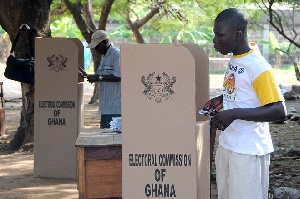Policy Think Tank, IMANI Africa which has been at the forefront of the ongoing campaign to expose the agenda by the Electoral Commission has provided a quick reference facts on critical issues procurement and technical, that concerned Ghanaians must fight to prevent chos.
IMANI in its publication reminds the public that the agenda was hatched as early as 2017. Besides the removal of former EC boss, Charllote Osei, an orchestration well planned to include other Commissioners, EC was doing same, terminated the old contractor, STL, four months into office. EC Chair, Jean Mensah then paid new consultants to take over the system. That is what she has used to run a range of elections so far including the referendum.
IMANI Questions the Electoral Commission’s (EC) decision to throw away 7,500 ultra-expensive laptops and accessories plus 72,000 expensive hand-held gadgets, bought and maintained with tens of millions of our hard-earned money, haven’t gone away.
A pall of uncertainty now hangs over the timeline to the elections, with its strict sequence of activities: registration, exhibition, adjudication, and compilation before distribution of the register to the political parties for their review. Coronavirus, rather than displacing this EC new biometric register matter from our priority list, has in fact reinforced the urgency with which we must handle this situation.
Question: The EC says the existing system isn’t in a good state for the general elections. They are the ones close to the situation. Shouldn’t we just give them the benefit of the doubt?
Answer: The EC provided a very specific reason why the system is not fit for purpose. Here is it in their own words: “The BVR kits are more than 7 years old and End-Of-Life (EOL) and can hardly be supported.“ They described all the different parts of the complex network of systems making up their technology platform in a similar way (See: https://www.graphic.com.gh/news/politics/election-2020-new-voters-register-newbiometric-voter-management-system-coming-electoral-commission.html). IMANI has carefully probed this very claim and found it to be untrue. What is shocking is that, to date, no media house has been brave enough to take the EC on for this totally false claim. The evidence of the EC’s mendacity has been provided on multiple occasions and shall be reproduced here too.
Question: STL may have padded their quotations and may have been milking Ghana as many have accused them over the years, but that does not still mean that the biometric system is not obsolete.
Answer: We will repeat once more for emphasis: the EC’s system is a “network of multiple equipment and software”. It is akin to a banking system (core software, ATMs, POSs, teller desktops etc) or a television production system (cameras, mixers, microphones, editing suites etc.). Different parts of the system tend to be overhauled at different paces. The system as a whole DOES NOT DATE FROM 2011. That claim was a blatant untruth. The country has spent over $60 million at least buying new equipment, software and licenses to upgrade, maintain, refresh and keep it up to date. Some of this equipment was even delivered after the present EC bosses came to office. According to a very connected journalist, this new cadre of EC bosses have taken delivery of as many as 150 of these very expensive devices.
The EC’s projected cost for refurbishing the system, which it says it got from STL, $74 million is wholly flawed because it is based on assumption of having to replace every single equipment and that STL shall intermediate the purchases. Since that is not necessary, and only a portion of the system needs replacement, the real cost of preserving the existing system for this electoral cycle is “only” $15 million, and not $74 million. This would mean 2000 more BVRs, 5000 more BVDs, data centre, and auxiliary service. On the other hand, the EC’s claims that buying a brand-new technology platform will only cost $56 million has been exposed to be untrue by the outcome of its just ended sham tender, which produced $72 million as the winning bid. The EC’s allies claim that renegotiation shall bring this amount to close to $60 million.
Question: Well, this is rather surprising. Which official documents are you relying upon to make these conclusions?
Answer: Page 18 of the Ministry of Finance’s 2019 Program Based Budget analysis of the EC. Page 12 of the 2017 version of that same document. Pages 8 and 9 of the 2019 report of the Special Budget Committee, a parliamentary oversight body that reviews the EC’s spending, and page 17 of the 2020 version of that same committee’s report. Pages 145, 146 and 153 of the Audit Service March 2019 report to Parliament covering the EC and other major institutions. Triangulating all these various sources lead to plain and incontrovertible verbs that the EC’s claim of the system dating from 2011 is a COMPLETE UNTRUTH.
How do you give the benefit of the doubt to an organisation insistent on denying the public the truth?
Question: What about the claims that the EC mentioned to parliamentary committees several times that the biometric system was obsolete and that even the just exited Chair of the commission signed some contracts which have not been honoured?
Answer: Yes, in 2018, the EC appeared before the relevant Parliamentary Committee and insisted that it needs additional BVRs. But note carefully: it confirmed on pages 8 and 9 of the resultant parliamentary (Special Budget Committee) report that all 7500 BVRs in its portfolio have been refurbished but that it still needs an additional 5000. In addition, it wanted to procure 5000 BVDs. This was clearly in view of the expansion of the number of polling stations and the need to maintain an excess margin in respect of the “Two BVDs per Polling Station” policy. Hence as late as 2018, according to the parliamentary record, the EC very much intended to keep the existing equipment. They just wanted to buy more items. In fact, in 2019, when they returned to the committee, they assured the members that the biometric system in its current state was fit to manage the upcoming elections. The only part of the EC’s system that it has been consistent in calling for a replacement is the datacentre. The contract for that component has already been awarded.
Question: Could it be that the recent EC is just distrustful of any system left behind by the previous administration and wants something she can be fully confident in as the procurer?
Answer: Please understand that the EC terminated the contract of the old contractor, STL, four months into office. She then paid new consultants to take over the system. That is what she has used to run a range of elections so far including the referendum. There is no validity to any such paranoia about an unreliable legacy system. Mere sentiment cannot be used to throw away a system valued at well over $60 million in order to spend $150 million buying a new one and collecting fresh data. $150 million is 85% the total value of recent annual allocations to the Road Fund, 70% of the value of the GET Fund, and 50% of the value of the National Health Fund. We are talking about money that can have massive impact on health, education and infrastructure.
Question: The argument has been made that Thales prevailed in an open and fair process and that none of the other bidders, Smartmatic or Idemia, was graded on a scheme not applicable to the others.
Answer: On 18th December, the EC management tried to force the original tender evaluation panel to eliminate Smartmatic and Idemia by way of a memo providing comments to the committee’s draft report. When that failed, they dissolved the committee. The new committee then found a way to eliminate Idemia on January 13th 2020 on technical grounds thus ensuring that Idemia never proceeded to the financial evaluation round.
Question: Your comments have been interpreted as being in favour of some of the vendors that lost out, perhaps Idemia and Smartmatics. Answer: Those inferences are plainly ridiculous. IMANI begun its opposition to the procurement of a new system in December when all these companies were busily bidding to win the contract. How can IMANI then be working for some of the companies, when our actions have been to deny them any money in the first place? Let’s repeat: the procurement issues are related to the risk factors. If the EC is mismanaging the procurement, it is also mismanaging the elections. If the EC is trying to rig a tender, then its motives for pushing for a brand new system becomes suspect.
Q: So why doesn’t IMANI go to court? A: There are public agencies resourced from our national purse to enforce the law and avert wrongdoing. CHRAJ, EOCO, CID, Attorney General’s Department, Auditor General etc. etc. The law and order dimensions of this matter must be directed to them, and we are happy to join the media and other CSOs make the case why they should act fast. We do not have the resources to be junketing from law court to law court forcing public institutions to do the right thing. But we can educate the public and media and hopefully increase the pressure for the institutions set up and funded to do that work to sit up and act.
Click to view details



General News of Thursday, 28 May 2020
Source: IMANI
IMANI Q&A: Vaccinating the nation against EC’s Propaganda
Opinions
















